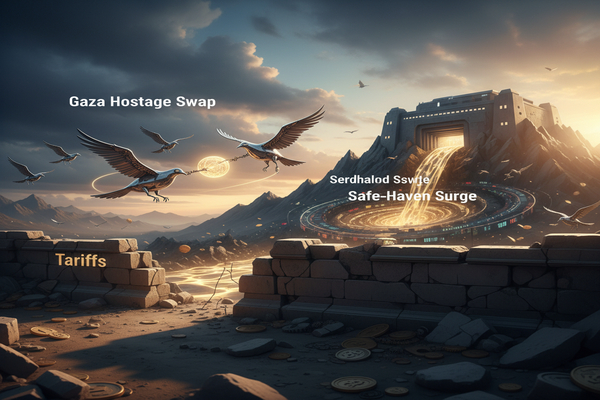
Markets face competing forces as US tariffs bite and a Gaza hostage swap eases acute geopolitical pressure. Tariff costs are draining US businesses and consumers now, while the truce in Gaza eases near-term risk premia. Short term, traders will watch inflation data and flows into safe havens. Longer term, tariffs could reroute supply chains and complicate Fed policy. Globally, the US will feel tariff pain directly, Europe faces spillovers through trade and inflation, and Asia could see both export disruption and demand shifts. Compared with the 2018-19 tariff cycle, cost pass-through appears faster now, making today’s session unusually sensitive to policy and geopolitical headlines.
Opening tone: traders weigh tariff pain against easing geopolitical stress
Tariffs press corporate margins while a Gaza truce cools immediate risk premiums
U.S. import levies are starting to show up in price lists and shipping papers. That is pressing margins for manufacturers and retailers. Consumers face higher at-the-register prices. The result is a mix of downward earnings revisions and upward price pressures for the Federal Reserve to consider. Meanwhile, the handover of the final surviving hostages from Gaza has reduced headline tail risk. That should lower some of the geopolitical risk premium traders have been demanding. However, calm on the streets does not erase trade friction. Expect volatility to fall in some asset classes while staying elevated in trade-sensitive names.
Macro implications: inflation, rates and central bank math
Trade-driven price gains complicate an already tight global inflation picture
Tariff-driven cost increases act like a new tax on consumption. In the United States, this can add to core inflation readings at a time when the labor market remains tight. That complicates the Federal Reserve’s inflation path and the communication it needs to deliver to markets. In Europe, energy and food trends remain the key drivers, but extra import costs from the United States can filter through global goods prices. In Asia, exporters may try to absorb or reroute costs, altering trade flows. Historically, tariff episodes such as 2018-19 produced a lagged but measurable uptick in goods inflation. If that pattern repeats, central banks will need to weigh the persistence of tariff effects against cooling demand. For the upcoming session, traders will parse any new data or comments that hint at faster pass-through or a policy response.
Market flows: where investors are moving money now
Safe havens rally while risk assets test whether earnings can withstand higher costs
Gold hitting fresh record highs signals strong demand for stores of value. That reflects lingering uncertainty and a bid from investors re-pricing risk. Equities have steadied after recent swings, but the composition of the move matters. Defensive sectors that can pass on costs or benefit from elevated prices show relative strength. Cyclical and export-dependent names face more pressure as tariffs bite. Credit markets will watch issuance and spread behavior closely given trillions of dollars of corporate funding needs. In addition, any comment from large financial players could shift sentiment. JPMorgan (NYSE:JPM) launching a major industrial investment plan for U.S. resilience will be watched for signals on banking appetite to finance long-term capital projects and on potential shifts in capital allocation. Markets will also monitor airline and aerospace supply chains. Airline groups warned of more than $11 billion in extra costs this year, which can dampen transport stocks and ripple into suppliers.
Corporate and regional headlines to watch during the session
National security moves and corporate supply stress add to headline risk
European markets have an added political angle with the French cabinet reconfiguration and calls for a change in direction to resolve budget talks. That can affect euro area sentiment if fiscal plans look unstable. In the Netherlands, state action to control a chipmaker underscores heightened scrutiny of strategic technologies and foreign ownership. That raises the prospect of more regulatory intervention in key sectors, especially in Europe and North America. In Asia, Taiwan’s defense spending on air defenses will be a regional reminder that geopolitics remains a structural variable. Meanwhile, pockets of real economic stress are visible. Reports of a major bus crash in South Africa and unrest in Madagascar add to local risk stories that can briefly affect commodity or regional flows. Investors will treat such news as reminders of idiosyncratic risk while focusing primarily on macro drivers in this session.
What traders should watch in today’s session
Inflation prints, Fed commentary, tariff signals and risk flows will move markets
The session will likely hinge on any fresh data on inflation and consumer prices and on comments from central bankers. Market participants will also watch trade and tariff updates for signs of escalation or de-escalation. Geopolitical headlines tied to the Gaza truce will matter for the short-term risk tone. Corporate updates from sectors facing immediate supply chain costs, such as airlines and manufacturers, can create pockets of volatility. Lastly, investor positioning into safe havens versus risk assets will determine whether equity indices hold gains or give them back. Expect fast reactions to headlines and a focus on forward guidance from policymakers rather than on single-day moves.
Overall, the market opens with a clear tug of war. Tariffs are squeezing costs and complicating the inflation outlook. The hostage exchange has reduced acute geopolitical premium but not removed structural trade risk. Traders will price today’s session with both pressures in view, weighing near-term headline relief against a longer-term cost drag that could shape earnings and policy conversations for months to come.












